
Armillaria luteobubalina, commonly known as the Australian honey fungus, is a species of mushroom in the family Physalacriaceae. Widely distributed in southern Australia, the fungus is responsible for a disease known as Armillaria root rot, a primary cause of Eucalyptus tree death and forest dieback. It is the most pathogenic and widespread of the six Armillaria species found in Australia. The fungus has also been collected in Argentina and Chile. Fruit bodies have cream- to tan-coloured caps that grow up to 10 cm (4 in) in diameter and stems that measure up to 20 cm (8 in) long by 1.5 cm (1 in) thick. The fruit bodies, which appear at the base of infected trees and other woody plants in autumn (March–April), are edible, but require cooking to remove the bitter taste. The fungus is dispersed through spores produced on gills on the underside of the caps, and also by growing vegetatively through the root systems of host trees. The ability of the fungus to spread vegetatively is facilitated by an aerating system that allows it to efficiently diffuse oxygen through rhizomorphs—rootlike structures made of dense masses of hyphae.

Armillaria novae-zelandiae is a species of mushroom-forming fungus in the family Physalacriaceae. This plant pathogen species is one of four Armillaria species that have been identified in Aotearoa New Zealand the others are A. limonea,A. hinnulea, A. aotearoa).

Armillaria limonea is a species of mushroom in the family Physalacriaceae. This plant pathogen species is one of four Armillaria species that have been identified in Aotearoa New Zealand the others are A. novae-zelandiae,A. hinnulea, A. aotearoa).
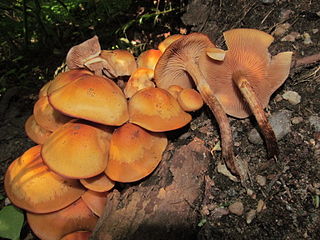
Armillaria nabsnona is a species of fungus in the family Physalacriaceae. The species is found in the west coast of North America, Hawaii, and Japan, where it grows on decaying hardwoods, particularly species of alder. Its fruit bodies have convex to flattened orange-brown caps up to 7 cm in diameter, brown stipes, and whitish to pinkish-tan gills.
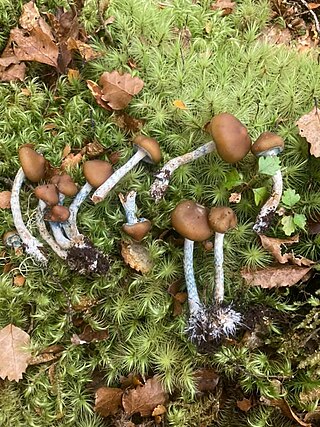
Psilocybe makarorae is a species of psilocybin mushroom in the family Hymenogastraceae. Officially described as new to science in 1995, it is known only from New Zealand, where it grows on rotting wood and twigs of southern beeches. The fruit body (mushroom) has a brownish cap with lighter coloured margins, measuring up to 3.5 cm (1.4 in) wide. The cap shape is either conical, bell-shaped, but as the mushroom grows, it expands to become convex, and it features a prominent umbo. Although the whitish stem does not form a true ring, it retains remnants of the partial veil that covers and protects the gills of young fruit bodies. P. makarorae mushrooms can be distinguished from the similar North American species Psilocybe caerulipes by microscopic characteristics such as the presence of cystidia on the gill faces (pleurocystidia), and cheilocystidia with more elongated necks. Based on the bluing reaction to injury, P. makarorae is presumed to contain the psychedelic compounds psilocybin and psilocin.

Lactarius subflammeus, commonly known as the orange milk cap, is a species of fungus in the family Russulaceae. It is found in western North America in the late summer and fall and is especially common in the Pacific Northwest, where it grows on the ground near conifers like pine and spruce. The brightly colored fruit bodies, which are slimy or sticky, have scarlet caps when young that soon fade to brilliant orange. The stem—typically longer than the width of the cap—is also bright orange but the gills are whitish. The mushroom secretes a whitish latex when it is cut or injured.

Amanita australis is a species of fungus in the family Amanitaceae. It produces small- to medium-sized fruit bodies, with brown caps up to 9 centimetres in diameter covered with pyramidal warts. The gills on the underside of the cap are white, closely crowded together, and free from attachment to the stem. The stem, up to 9 cm long, has a ring and a bulbous base. The mushroom may be confused with another endemic New Zealand species, A. nothofagi, but can be distinguished by differences in microscopic characteristics.

Amanita nothofagi is a species of fungus in the family Amanitaceae. Endemic to New Zealand, the species was first described by mycologist Greta Stevenson in 1962. The fruit bodies have dark brown caps that are up to 13 cm (5.1 in) in diameter and covered with patches of soft greyish-brown scales or warts. The gills underneath the cap are crowded together, free from attachment to the stem, and white, becoming tinged with yellow in age. The stem of the mushroom is 4–14 cm (1.6–5.5 in) long by 0.5–2.5 cm (0.2–1.0 in) thick, and has a ring. The spore print is white, and individual spores are spherical to ellipsoid, measuring 7.5–9 by 7.5–9 micrometres. The mushroom may be confused with another New Zealand species, A. australis, but can be distinguished by certain characteristics. Amanita nothofagi is a mycorrhizal species, and grows in association with native New Zealand trees such as Southern Beech.

Amanita atkinsoniana, also known as the Atkinson's amanita, is a species of fungus in the family Amanitaceae. The fruit body is white to brownish, with caps up to 12.5 centimetres in diameter, and stems up to 20 cm long. The surface of the cap is covered with brownish conical warts.
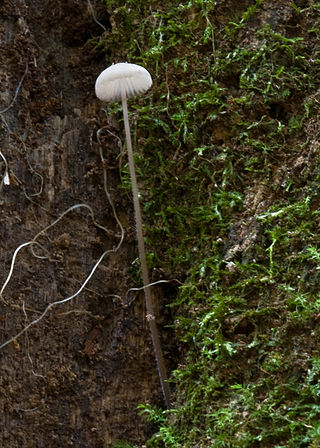
Mycena cystidiosa is a species of mushroom in the family Mycenaceae. Described as new to science in 1964, it is known only from New Zealand and Australia. The fruit bodies have a broadly conical small white cap up to 12 mm (0.5 in) wide, with distantly spaced cream-coloured gills on the underside. The stipe is particularly long, up to 20 cm (8 in), with an abundant covering of white hairs at the base. The species is known for its abundant rhizomorphs—long, root-like extensions of mycelia.
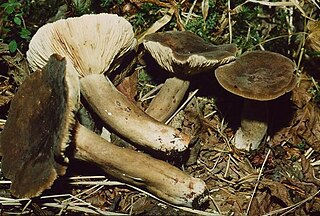
Lactarius fuliginosus, commonly known as the sooty milkcap, is a species of fungus in the family Russulaceae. The medium-sized fruit bodies have velvety, grayish-brown caps and crowded gills. It is found in deciduous forests of Asia, Europe, and North America.

Boletopsis nothofagi is a fungus in the family Bankeraceae. The fungus forms grey fruit bodies that grow in clusters. Like all species of Boletopsis, it has a porous spore-bearing surface on the underside of the cap, but differs from other species of Boletopsis by having characteristics such as elongated spores and a green discoloration when stained with potassium hydroxide. Boletopsis nothofagi is endemic to New Zealand and has a mycorrhizal association with red beech. It is unknown when exactly the fungus forms its fruit body, but it has so far been found solely in May, during autumn in the Southern Hemisphere.

Tricholoma vernaticum is an agaric fungus of the genus Tricholoma native to the Pacific Northwest region of the United States. The fungus was originally described in 1976 as a species of Armillaria when that genus was more inclusive; it received its current name twenty years later. The stout fruit bodies (mushrooms) have moist white to grayish caps, a membranous ring on the stipe, and an odor resembling cucumbers. Mycorrhizal with conifers, the fungus fruits in the spring or early summer, with its mushrooms appearing on the ground singly or in groups at high elevations, often at the edge of melting snowbanks. The edibility of the mushroom is unknown, but it has a strong unpleasant odor and a mealy taste.
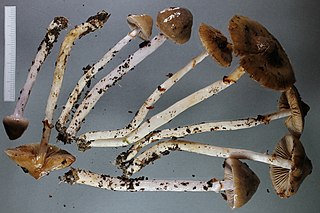
Cortinarius cucumeris is a basidiomycete fungus of the genus Cortinarius native to New Zealand, where it grows under Nothofagus.

Tyromyces pulcherrimus, commonly known as the strawberry bracket, is a species of poroid fungus in the family Polyporaceae. It is readily recognisable by its reddish fruit bodies with pores on the cap underside. The fungus is found natively in Australia and New Zealand, where it causes a white rot in living and dead logs of southern beech and eucalyptus. In southern Brazil, it is an introduced species that is associated with imported eucalypts.
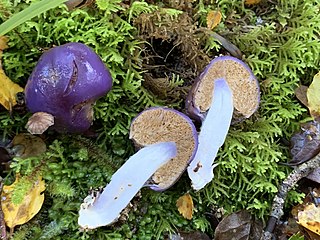
Cortinarius purpureocapitatus is a species of purple pouch fungus in the genus Cortinarius. It is endemic to Aotearoa New Zealand.

Cortinarius diaphorus is a species of purple pouch fungus in the genus Cortinarius endemic to Aotearoa New Zealand.

Cortinarius violaceocystidiatus is a species of purple pouch fungus in the genus Cortinarius. It is endemic to Aotearoa New Zealand.

Pluteus microspermus is a saprotrophic, mushroom-like (agaricoid) fungi in the Section Pluteus. It is often confused with Pluteus concentricus, a species endemic to New Zealand because P. concentricus also has concentric ridges on its cap (pileus). P. microspermus and P. concentricus can be differentiated by microscopy as the spores are different sizes. P. concentricus also has rougher material on its stipe.

Clavulina vinaceocervina var. avellanea is a variety of the Clavulina vinaceocervina species. It has been previously described as characterised by its fleshy brown to violaceus tan colour, contrasting the typical variety of Clavulina vinaceocervina, Clavulina vinaceocervina var. vinaceocervina, which has a pinkish-rosy colour. Observations of Clavulina vinaceocervina var. avellanea since, however, have also shown a pinkish-rosy colour.



















